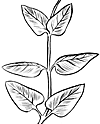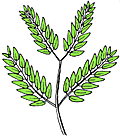Silky Oak
Grevillea robusta
Compound Flower family (Proteaceae)
Post-Cook introduction
oak, a handsome Australian tree planted for shade, ornament, and reforestation, also widely naturalized, is recognized by the and deeply fern-like leaves, dark green above, with whitish or ash-colored hairs beneath, by the showy, yellowish flowers clustered on one side of slender stiff axes, and by black curved pod-like with slender stalks and

©2005 Forest And Kim Starr
Leaves fernlike, 6–12 inches (15–30 ) long, almost with 11–21 side axes () 1 1⁄2–3 1⁄2 inches (4–9 ) long, deeply divided into narrow long-pointed 1⁄4–1⁄2 inch (6–13 ) wide, with borders turned under, shiny and hairless above, slightly thickened.
Flower clusters () 3–7 inches (7.5–18 ) long, unbranched, arise mostly from the trunk, along twigs back of leaves, and at leaf bases. Flowers numerous with long slender stalks 3⁄8–3⁄4 inch (1–2 ) long, crowded on one side of the axis. They are composed of four narrow yellowish almost 1⁄2 inch (13 ) long, curved downward; no petals; four stalkless inserted on and them; and with stalk, long slender curved and enlarged
podlike () are broad, slightly flattened, leathery, with long slender curved splitting open on one side, remaining attached. Seeds one or two, 3⁄8–1⁄2 inch (10–13 ) long, elliptical, flattened, winged, brown. Flowering from April to autumn, but predominantly April–May.
The pale pinkish brown wood is attractive because of the prominent resembling oak, as the common name suggests. This was the former “lacewood” of world trade until it became scarce in Australia. It is of moderate density ( gr. 0.57), has low radial but high tangential shrinkage in drying and is one of the best woods in all-around machinability ever tested by the Forest Products Laboratory. Sawdust causes dermatitis to fair skinned people. The wood is not resistant to decay or termites, and sapwood is highly susceptible to ambrosia beetle attack while in the log. Suitable for face veneer as well as paper pulp. It has very long fibers for a hardwood. In Hawaii, the wood has been utilized for furniture, cabinetmaking, paneling, interiors, and in one house including the framing.
The trees are propagated readily from the great quantities of seeds, grow rapidly, and are drought resistant. Along the road to Kokee State Park, Kauai, trees are unhealthy with ragged crowns. Elsewhere, trees have full crowns.
Introduced into Hawaii about 1880 from Australia, it is now seen as a shade tree and street tree through the islands from sea level to 4000 ft (1219 ). This species is the second most commonly planted tree in Hawaii after robusta eucalyptus, Eucalyptus robusta. It is hardy in dry soils, quick growing and pest-free. Although it has been planted mostly in drier areas, it does best where planted in moist sites with 60–80 inches (1524–2032 ) rainfall. The trees scatter their winged seeds and have become undesirable weeds in some pastures and rangelands of Hawaii, requiring eradication. There are extensive naturalized stands on Kapapala Ranch in Ka‘u and Huehue Ranch in North Kona. Hawaii has 3 million board feet of sawtimber and Oahu 2.5 million, mostly in the Honouliuli Forest Reserve.
In some countries, the trees have served as coffee shade. Some were planted for this purpose in Kona in the early part of the century. This species is classed as a honey plant.
Planted for ornament and shade in central and southern Florida, where it is but not naturalized. There it is recommended as a fast-growing flowering tree for well drained and sandy soils, being both cold hardy and drought resistant. Formerly planted in Puerto Rico, but now not used because of susceptibility to insects. Introduced also in southern Arizona and California. Northward in temperate climates, as in continental United States, the fern-like plants are grown indoors in pots.
Special areas
Waimea Arboretum, Kalopa, Tantalus
Champion
Height 90 ft (27.4 ) c.b.h. 10.6 ft (3.2 ), spread 47 ft (14.3 ). State Forestry Arboretum, Hilo, Hawaii (1968).
Range
Native of Australia but widely introduced and naturalized in tropical and subtropical regions of the world.
Other common names
silver-oak, ‘oka kilika, ha‘iku ke‘oke’o (Hawaii); roble de seda, roble australiano (Puerto Rico); grevilea (Spanish)
Botanical
Stylurus robusta (A. Cunn.) Deg.
Grevillea was dedicated to Charles Francis Greville (1749–1809), British horticulturist.








